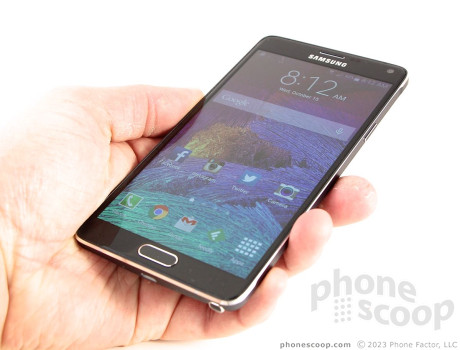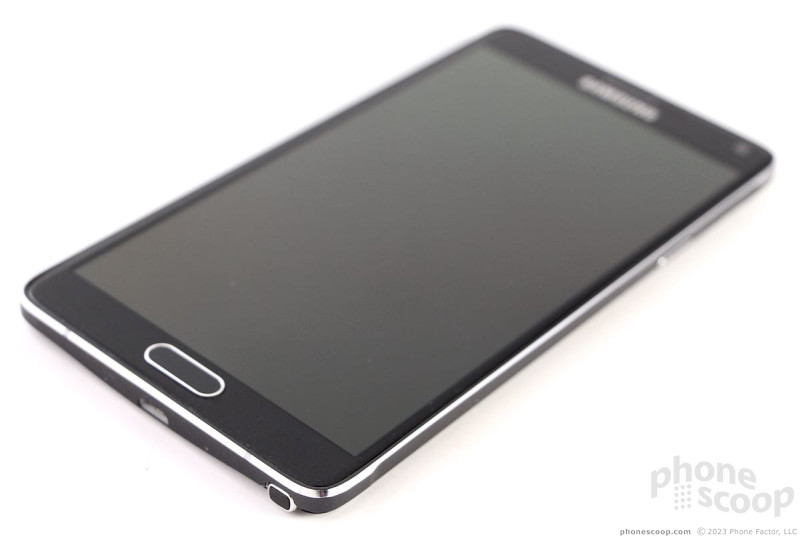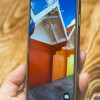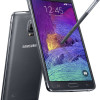Review: Samsung Galaxy Note 4 for AT&T
Oct 15, 2014, 8:00 AM by Eric M. Zeman

Samsung is back with a new Note. This time around Samsung went bolder, but not necessarily bigger, with the Note 4. One might call it the ultimate phablet. Here is Phone Scoop's full report on one of the most anticipated Android smartphones of the year.
Is It Your Type?
The Galaxy Note 4 is Samsung's top-of-the-line device. It boasts the best of everything. Its bells and whistles are stuffed with bells and whistles. The Note 4 is for those who want it all: the ultimate in size, screen, camera, multitasking, and productivity. It is a beast of a phone, and one of Samsung's finest efforts.
Body
When approaching the Note 4, Samsung said it decided to listen to customer feedback. It took to heart some of the complaints levied at its design and material choices and aimed to correct them. In that respect, Samsung partially succeeded. The Note 4 is a step up from the Note 3, no doubt, though it carries over many of the basics that have defined the Note series from the very beginning.
The Note 4 is a classy - if busy - device. There are different shades, materials, angles, and surfaces all over the place. The front is glass, the side edges are aluminum, and the back is polycarbonate. You'll see black, gray, and chrome-colored accents. It borders on chaotic, and is the antithesis of Apple's minimalistic approach to design. The front glass is smooth and curves downward ever-so-slightly right where it meets the aluminum frame. The frame itself is half painted and half polished. The frame has chamfers where it joins the front and back surfaces, and the chamfers are bare, gleaming metal. I honestly can't understand why Samsung painted the rest of the frame. I think it would look better if the entire frame were polished. The back cover carries over the faux leather look from last year's phone, but does away with the cheesy fake stitching. It looks better.
As with all phablets, the Note 4 is sizable. It measures 6.04 x 3.09 x 0.33 inches, which is slightly smaller than the Note 3 (5.95 x 3.12 x 0.33 inches), and the iPhone 6 Plus (6.22 x 3.06 x 0.28 inches). It is the heaviest of these three devices, probably due to the aluminum frame. I would call one-handed usability of the Note 4 and iPhone 6 Plus about dead even. I have a hard time reaching the top portions of the Note 4's screen without adjusting my grip. Most often, I elected to use two hands instead of one. (The Note 4 has several software tricks to make it easier to use with one hand, such as moving the keyboard/dialer to one of the lower corners.) Despite the chamfers, the Note 4 has noticeable edges that feel a bit harsh against your palm. This gripe aside, the Note 4 is easily the highest-quality device Samsung has produced. It easily bests earlier generations of hardware. Like most big phones, the Note 4 will fit easily into some pockets and not-so-easily into others.
The Note 4's face is relatively clean. Only a few design elements interrupt the glass. Samsung has long preferred a physical button and the Note 4 is no different. The home button is wide and rimmed with a chrome accent. It has a great profile and superb travel and feedback. The Note 4 has two capacitive buttons, one to either side of the Home key. The Recents (or multitasking) button is on the left, and the Back button is on the right. Both offer haptic feedback if you wish and function perfectly. I didn't have any trouble finding or using them. The Samsung logo rests above the display, and is crammed beneath a cut-out in the glass for the earpiece speaker. The user-facing camera is plainly visible in the upper-right corner, and an alert light blinks in the upper-left corner.
Samsung has gussied up the side edges a bit. The Note 3 had a polycarbonate frame. Samsung traded the polycarbonate for aluminum. Like the frame itself, the buttons along the edge have been painted and polished. The volume toggle is on the left. The flat surfaces are painted the same gray as the rest of the side surface, but the edges of the button are polished to help it stand out visually. I like the result. The toggle itself has a great profile and excellent travel and feedback. Ditto for the lock button on the right side. There is no dedicated camera button. The headphone jack is on top and the USB port is on the bottom. Interestingly, the Note 4 ditches the USB 3.0 SuperSpeed port found on the Note 3 and reverts to the much more common (but slower) micro-USB High Speed port. The S Pen is tucked into the bottom edge and is easy to retrieve and replace.
Like its predecessors, the Note 4's rear cover is removable. The polycarbonate panel is far superior to those used on older phones. It's tougher, stronger, and flexible. You can bend it in half and not break it. I could live without the fake leather texture, but it's better than the Galaxy S5's dimpled band-aid look. It peels off with a bit of prying and snaps back in place just as easily. With the cover off, you have access to the battery, SIM card, and memory card slot. All three are easy to interact with. Many count the removable battery as a major selling point.
There's no question that the Note 4 is the best Note hardware yet.
Comments
Still At A Loss.
I understand that these are handheld products and how they "feel" plays a certain part in purchases by some people. But, in the same principle, they are also mobile devices that are subject to almost unlimited elements of destruction and 95% of users tend to use a case on the phones. This inherently negates the "feel." All the excuses in the world don't change this fact.
As the author pointed out, you can bend the rear panel and not have it break. Isn't this important for durability? To me, this says millions on what punishment a device can...
(continues)
(continues)
The second fallacy is that us...
(continues)


















 Hands on with Samsung's Galaxy Note 4
Hands on with Samsung's Galaxy Note 4
 Liveblog of Samsung Galaxy Note event
Liveblog of Samsung Galaxy Note event
 AT&T Selling Samsung's Virtual Reality Headset
AT&T Selling Samsung's Virtual Reality Headset
 Samsung Releases Milk Video
Samsung Releases Milk Video
 Samsung Note 4 Is More of A Big Thing
Samsung Note 4 Is More of A Big Thing
 Samsung Galaxy Note 4 (GSM)
Samsung Galaxy Note 4 (GSM)




